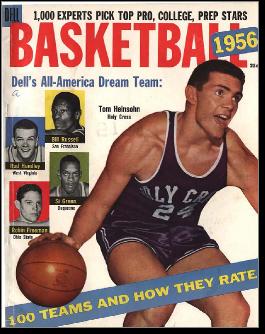
Sport: Basketball
Born: August 26, 1934
Died: November 10, 2020
Town: Jersey City, New Jersey
Thomas William Heinsohn was born on August 26, 1934 in Jersey City, NJ. He attended St. Michael’s High School, a Catholic school located in neighboring Union City. At St. Michael’s, Tom grew to 6’7″ and played center. He was one of the few high-school big men with a good jumpshot. He honed this weapon in gyms with low ceilings and, in some cases, overhanging tracks. As a result, the trajectory of his shot—even after reaching the pros—was noticeably flat.
Heavily recruited, Tom accepted a scholarship to Holy Cross in Massachusetts. As a sophomore, Tom was a key member of the Crusaders team that won the NIT championship. He scored 20 in the final against Duquesne. The Holy Cross captain and MVP of the tournament was Togo Palazzi. Tom and Togo had been rivals in high school; Palazzi played for Union Hill, a public school in Union City. The Crusaders also won the 1954 Sugar Bowl tournament. In the final, Tom outplayed Bob Pettit of LSU.
As a senior, Tom averaged 27.4 points per game and was a first-team All-American. He finished with a 22.1 average over three seasons. Holy Cross lost only 14 games during his varsity career.
The Boston Celtics claimed Tom as a territorial pick in the 1956 NBA draft. He moved to forward and gave the Celtics a player who created nightmare match-ups for opponents—especially with Bob Cousy whipping passes all over the court. Tom could rebound like a center and shoot jumpers like a guard. He was named Rookie of the Year for the 1956–57 season.
When Bill Russell and K.C. Jones joined Boston the following season, the Celtics became nearly unbeatable. They won the NBA championship in 1957 and again each year from 1959 to 1966. A great pressure player, Tom often boosted his scoring and rebounding during the postseason. Never timid about putting up a shot, Tom earned the nickname “Ack-Ack” after the World War II antiaircraft guns.
On a team of stars, Tom wasn’t always the go-to guy, but he was often the open man. As a result, he led the Celtics in scoring three years in a row from 1959–60 to 1961–62, averaging 21.7 per game during that span. Tom wasn’t lacking for recognition, either. He was selected to play in the All-Star Game six times. Prior to the 1964 game, Tom—who was by then the president of the Players Association—led the players in a threatened strike. This bold move was a watershed moment for the NBAPA and laid the foundation for free agency years later.
Tom retired after the team’s 1965 championship with more than 12,000 points and 5,000 rebounds. He averaged 18.6 points and 8.8 rebounds per game. His number 15 was retired by the team and he was inducted into the Hall of Fame in 1986.
By then, Tom had fashioned a second career as coach of the Celtics. He took over after Russell’s retirement and was charged with the task of rebuilding the team. Between his retirement and his coaching hire, Tom called Celtic games on the television. Among the players Tom developed were Jo Jo White, Don Chaney and Dave Cowens. He also extended the careers of veterans Don Nelson, John Havlicek and Paul Silas. Under Tom, the Celtics won NBA championships in 1974 and 1976. He was named coach of the year in 1972–73. Tom stepped down as coach after the Celtics started slowly in 1977–78.
Tom returned to the broadcast table in 1981, teaming up with Mike Gorman to call Celtic games. The partnership continued for more than three decades—one of the longest-lasting sports broadcast duos in history—with Tom easing into a studio role for away games toward the end of his career. In his 80s, chronic health problems, including diabetes and COP, took him away from basketball and he died in 2020 at the age of 86.